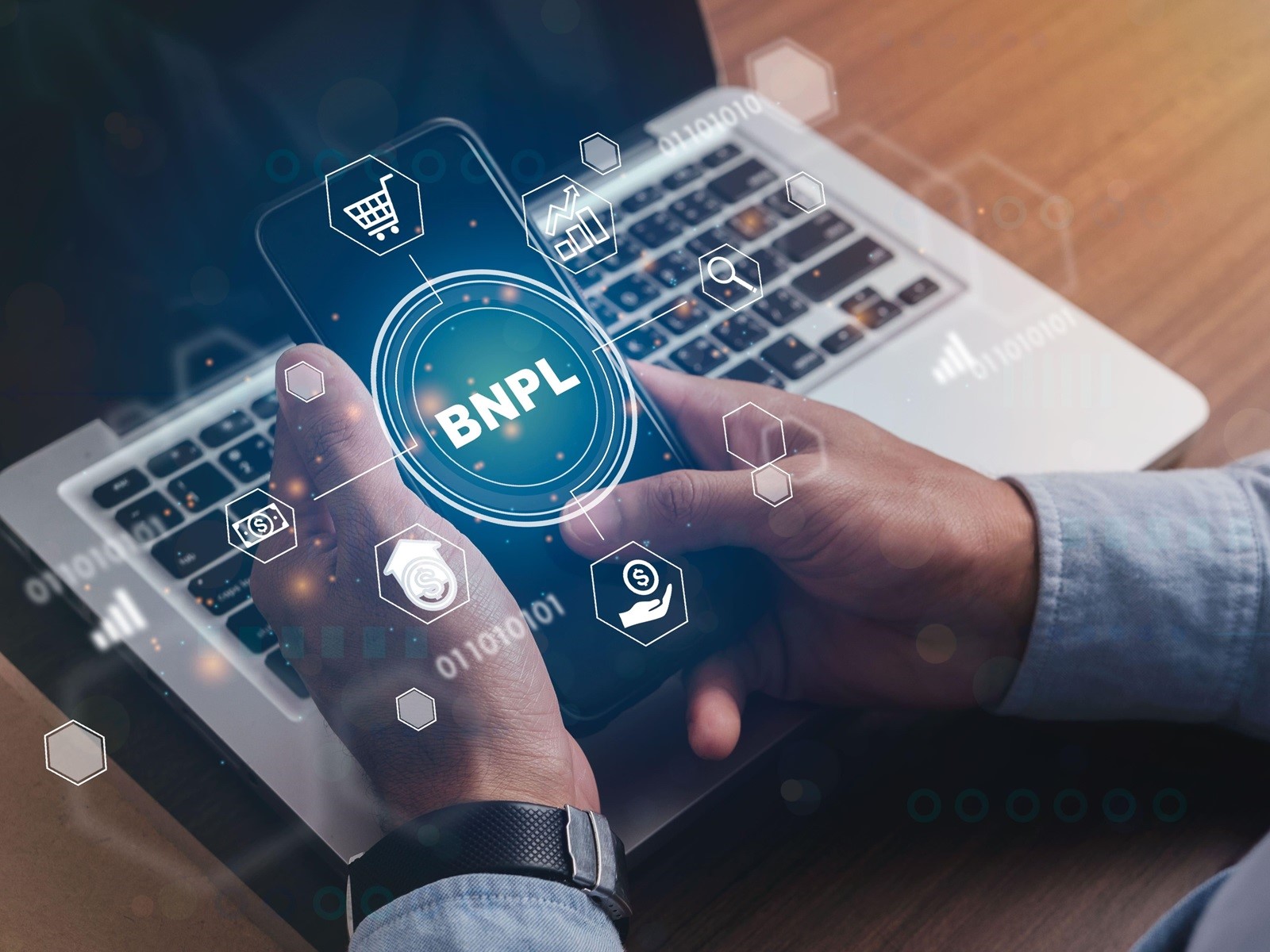Buy Now, Pay Later (BNPL): 6 different ways they can work

The majority of Buy Now, Pay Later companies have been around since the 2010s, and in that time, we’ve seen a handful of companies dominating the market, while many others have failed.
We’ve also experienced an evolution of BNPL, with new models being developed and new niches being carved out, in part due to regulatory changes, and in part due to economic unrest.
Whilst there are new entrants and models making inroads into the B2B space, including Hokodo, Two Mondu, and Billi, in this post, we look to explore the BNPL B2C models in detail to help you understand how they can help your business, no matter the industry and region you operate in.
1. Own-brand
Own-brand, also known as pure-play and proprietary Buy Now, Pay Later providers, fall under what is likely the best-known of all BNPL models.
It includes BNPL providers such as Klarna, PayPal Pay in 3, and Clearpay (AKA Afterpay outside of the UK). These well-established industry players have built their model around offering short-term financing for low and mid-range purchases.
These providers integrate into a merchant checkout page, either directly, or via a payment service provider, offering consumers the option to break down purchases into more manageable instalments.
As many BNPL loans from own-brand providers fall under the minimum amount required to be regulated, they are not subject to the same regulatory restrictions as regulated lenders - at least not in the UK, yet. In other jurisdictions, regulators are taking action to improve protection for consumers.
As regulations roll out more widely, some own-brand BNPL companies may find themselves struggling. Becoming a regulated entity is costly, and those without a big enough customer base or capital are likely to fail.
Even established players have run into trouble, despite not being directly impacted by the introduction of new regulations. As evidenced by Laybuy’s recent collapse, having thousands of customers amounts to nothing if the business is not profitable.
This is where Klarna has a huge advantage. Klarna is a fully licensed bank regulated by the Swedish Financial Services Authority. Klarna had the benefit of being one of the first BNPL companies and focused heavily on promoting its business to raise awareness, further accelerating its growth. Its investment early on paid off - they last reported a 36% increase in revenue year on year, reaching over 150m consumers. No matter what regulatory or economic changes come along, they are big enough to weather the storm.
Similarly, PayPal’s BNPL offering, PayPal Pay in Three has become hugely successful, in part, due to its huge reach as a global digital wallet and brand clout.
No matter what industry you serve, the benefits of integrating ‘own-brand’ BNPL providers into your checkout process are clear; they result in higher average order values and help to reduce cart abandonment significantly.
2. Network Instalments
Not wanting to be left out, the payment networks have also entered the BNPL arena.
Both Visa and Mastercard offer BNPL solutions which open up instalment financing to cardholders. This is done by enabling existing credit lines to be converted into BNPL options at checkouts.
American Express has also entered into the space with its Plan It offering, which allows its customers to pay for purchases or a portion of their balance over time in equal monthly instalments over 3, 6 and 12 months, mirroring popular BNPL offerings from would-be credit card disruptors.
Positioned as ‘instalment solutions’ or ‘instalment-based payments’, the network model allows merchants to display instalment plans that card issuers then make available to eligible cardholders. Cardholders can then make fixed monthly payments over a preselected number of billing cycles on their eligible cards (debit, credit and prepaid).
The network instalment model is gaining traction, particularly in Canada, where Visa has partnered with Amazon.
Adoption in other markets has been slow, particularly in the UK and the rest of Europe. However, with the potential for mandates from the schemes to increase availability, it will be interesting to see if these begin to take off in the next couple of years.
3. BNPL for traditional banks and credit institutions
Banks may not want to build their own BNPL infrastructure, but they do want to benefit from improving stickiness with their customers by offering it.
HSBC, Citi, Natwest, and JPMorgan Chase have entered the BNPL market through partnership with existing BNPL providers, by investing in BNPL aggregators, or collaboration with FinTechs that specialise in delivering the underlying technology that powers BNPL products.
FinTech companies that build infrastructure for banks, have stepped in to create white-labelled BNPL solutions, helping them accelerate their entry into the market. These specialist companies include Temenos, Fimple, and Jifiti, to name a few.
However, despite a few banks embracing BNPL, in UK markets, few have succeeded so far. Natwest launched its BNPL offering back in 2022, only for it to be scrapped less than two years later due to low adoption. Additionally, Divido, a UK-based BaaS that focused on providing white-label BNPL products, has recently gone into administration, despite backing from HSBC and ING.
In the US, recent changes to BNPL regulation have given banks a competitive edge, particularly as they have large balance sheets, while holding a wealth of data on customer creditworthiness, and their high level of trustworthiness among consumers.
Citizens Bank is one such example, partnering with Jifiti to capitalise on the BNPL opportunity in home technology.
4. Aggregators for BNPL
For merchants that want to offer a more flexible BNPL solution, there are now BNPL aggregators that will act as an intermediary between multiple BNPL providers to provide customers with a choice at the checkout.
These aggregators include ChargeAfter and Deko, and established payment system companies like ACI Worldwide, with their ACI PayAfter solution.
Through a single platform, merchants can access a panel of lenders which seamlessly integrates into their checkout - all a customer has to do is select BNPL as a payment method and after assessing their eligibility across multiple lenders, they will be presented with the best short-term financing options available to them.
By expanding beyond offering a handful of own-brand BNPL, merchants can increase acceptance rates, and therefore conversion rates without having to enter partnerships with multiple providers.
5. Existing credit line based BNPL
In the BNPL credit line space, there is one provider that dominates the market.
Splitit works differently from other BNPL card offerings, as it allows customers to utilise their existing credit balances to split purchases into interest-free instalments. This means that customers do not have to enter into a new credit agreement, and can still take advantage of their existing card benefits, such as offers and rewards.
So how does SplitIt work?
Once a purchase is made, the merchant charges the customer's card every month with the instalment plan they selected at checkout. In addition to this charge, on their card statement, they will see an ‘authorisation hold’, meaning that the held amount appears as a pending transaction for the entire amount outstanding.
It may appear as a pending transaction on the card statement, but it’s not a charge. The purpose of the authorisation hold is to guarantee the payment. These authorisations will continue to decrease by one instalment amount every month, until the purchase is paid in full. Additionally, no fees or interest charges are applied by SplitIt, and no credit check is performed.
Although Splitiit is popular in the US, it is lagging behind in other jurisdictions. This may be due to credit cards remaining the preferred payment method amongst US consumers, whereas elsewhere, the most popular payment methods vary from country to country.
Splitit’s solution should not be confused with announcements from some card providers that they offer BNPL.
Banks and digital wallets including Monzo and Curve have offered BNPL cards, which work very much in the same way as a credit card.
Monzo Flex gives its customers three months of interest-free monthly instalments on transactions, with payments over 6 or 12 instalments charged at 29% APR variable. Curve Flex lets its customers spread the cost of large purchases they've made in the past 12 months by breaking them down into more manageable instalments, and crediting the cash back into their account.
6. Big ticket BNPL
One of the most underserved markets in BNPL is for big ticket purchases.
For decades, the only ways consumers have been able to split the cost of high value purchases has been through regulated credit agreements at the point of sale, or by taking out a credit card or loan. But now, BNPL providers like Newpay are seizing the opportunity to make it easier for customers and merchants alike to access credit for more expensive products and services.
Big ticket BNPL providers can offer interest-free payment plans, offering unregulated big ticket loans for up to 1 year (12 instalments) up to £3,000, and longer-term multi-year regulated products up to £30,000 - significantly higher than own-brand BNPL, which max out at around the £5,000 mark, depending on the jurisdiction they operate in.
This gives merchants who sell high-end goods, jewellery, appliances, and furniture a huge advantage, as well as travel businesses, who can now offer consumers the option to pay off their holiday in more affordable chunks.
Additionally, high ticket BNPL provides consumers with an alternative to taking out a traditional loan with high interest rates, or having to save up to get home renovations and improvements done, making it a great solution for retailers operating in this space.
There is also scope for this to work well in other industries, such as private healthcare, dentistry, and veterinary care - access to which has previously been dominated by insurance companies. This way, customers can avoid having to pay an excess or risk their policies rising when using these services.
Explore Ecommpay’s Buy Now, Pay Later solutions
Buy Now, Pay Later is becoming one of the most popular ways to pay. No matter what industry you operate in, there is a BNPL solution for you.
The BNPL market is evolving quickly, and at Ecommpay, our team is monitoring developments in the space to ensure we help our customers stay ahead of the curve, particularly in the US and Asia, where aggregator and credit line based models are growing.
As well as backing established BNPL providers, such as PayPal Pay in 3 and Klarna, who we are confident will remain stable and here to stay, we're also adding a specialist BNPL provider for big ticket items and for industries with higher average basket sizes as we recognise the need in this space.
We are also working closely with card schemes and networks to support new products as markets evolve to be ready for them.
Ecommpay offers BNPL payment solutions from a number of providers, and will work with you to find the best fit for your business.
